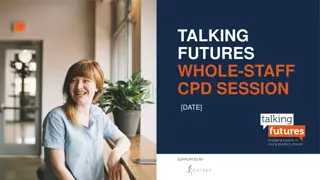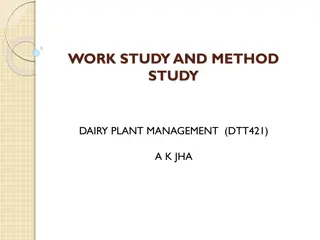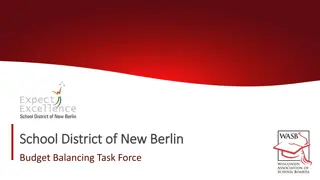PRESENTING AND TALKING ABOUT YOUR WORK.
Explore tips and techniques for addressing academic, policy, and public audiences effectively. Learn how to introduce yourself and your work, craft engaging elevator pitches, and navigate various academic conferences. Discover key conferences and specialized events to enhance your academic presentation skills.
Download Presentation

Please find below an Image/Link to download the presentation.
The content on the website is provided AS IS for your information and personal use only. It may not be sold, licensed, or shared on other websites without obtaining consent from the author.If you encounter any issues during the download, it is possible that the publisher has removed the file from their server.
You are allowed to download the files provided on this website for personal or commercial use, subject to the condition that they are used lawfully. All files are the property of their respective owners.
The content on the website is provided AS IS for your information and personal use only. It may not be sold, licensed, or shared on other websites without obtaining consent from the author.
E N D
Presentation Transcript
PRESENTING AND TALKING ABOUT YOUR WORK SARAH K. BRUCH
AGENDA ACADEMIC AUDIENCES POLICY AND PRACTITIONER AUDIENCES PUBLIC AUDIENCES
ACADEMIC AUDIENCES Introducing yourself and your work (academic introductions and elevator pitches) Academic Conferences
INTRODUCING YOURSELF AND YOUR WORK TO ACADEMIC AUDIENCES Academic Introductions statement of who you are as a researcher not just listing of projects or topics more general interests/areas and main projects
INTRODUCING YOURSELF AND YOUR WORK TO ACADEMIC AUDIENCES Elevator Pitch of dissertation or main project 1-2 sentences about your research broadly (significance/motivation and question your research tackles, the hook to capture attention) 3-5 succinct sentences to explain the general topic and nature of your research, avoiding specialized jargon. 1-2 sentences that connect your research back to the important issue you led off with, how it contributes to the field, and what's next for your work.
ACADEMIC CONFERENCES: NATIONAL POLICY, ADMINISTRATION, URBAN AFFAIRS, PLANNING Association for Public Policy Analysis and Management (APPAM) Annual Fall Research Conference Regional Student Conferences (DC and CA) Public Management Research Association (PMRA) Urban Affairs Association (UAA) American Political Science Association (APSA) Association of Collegiate Schools of Planning (ACSP) multiple conferences for different audiences including research Network of Schools of Public Policy (NASPAA) several conferences for different audiences
ACADEMIC CONFERENCES: SPECIALIZED AND REGIONAL/INTERNATIONAL Specialized area/topic conferences Examples: AERA for education policy; REC for social policy) Regional conferences Examples: ESS, MSA, MPSA International conferences or conferences for other national associations Examples: ISA, BPSA
ACADEMIC CONFERENCES HOW DO THEY WORK? Purposes of attending Calls for proposals Submission process Selection process Presenting what to expect and tips/advice
ACADEMIC CONFERENCES PURPOSES So many opportunities . To share your work (and work in progress) to academic audiences. To get feedback on your work (especially if there is a discussant). To see and hear about work related to your own (your panelmates and also other sessions at the conference). To meet people doing work related to your own (but also more generally in the field). To identify potential co-authors and, potential letter writers for tenure process.
ACADEMIC CONFERENCES PURPOSES And more opportunities . Help communicate professional memberships which are important because they send a signal about your work and how your work fits into the field/area. Attend informal networking opportunities and social events where you can meet others in your field. Attend workshops - professional development and/or data or methods workshops at the start or just prior to the conference, during, or after the conference.
ACADEMIC CONFERENCES HOW DO THEY WORK? Calls for proposals (papers, posters, panels) usually several months prior to conference. Send via email lists and posted on websites (good reason to be member of professional associations or be on mailing lists)
ACADEMIC CONFERENCES HOW DO THEY WORK? Submissions Typically can submit a single paper, a poster, and sometimes a full panel (3-4 papers with discussant and chair). Sometimes can indicate that first choice is presenting paper but also interested in presenting as poster if not accepted. Organizing whole sessions/panels both increases the probability that you'll be accepted, as well as helps you to network in the field and know more about what others in your area are currently working on. Requirements Some require abstracts (200-500 words), some extended abstracts (5-7 pages w/ some initial results), some require entire papers. Typically need to indicate which sections or topics are most relevant to your submission.
ACADEMIC CONFERENCES HOW DO THEY WORK? Selection Process Academic peer review process of proposals for selection. Typically organized by topic/area and coordinated by program committee and/or section chairs Faculty identified by program committee/section chairs or solicit volunteers from membership Notified of acceptance a few to several months prior to conference Sometimes have feedback on proposal, sometimes not.
ACADEMIC CONFERENCE PRESENTATIONS PAPERS AND PANELS General format is 10-15 minute presentation (using PPT) on panel with 2-4 other papers; but some conferences have roundtables as well (make sure to find out about the format!!) General content (background/motivation, research questions, data and methods, findings, implications/conclusions) General tips (have roughly as many slides as minutes in presentation, use visuals instead of tables when possible, don t use too much text, don t read your slides verbatim, don t use text that is too small for an audience to read) Preparation (practice your presentation with an audience to get feedback, time yourself) Resources: Speaking at APPAM Best Practices (link); APSA participation guide (link); Loyola tips sheet (link);
ACADEMIC CONFERENCE PRESENTATIONS POSTERS Make sure that you find and pay particular attention to the requirements for the poster Keep text to a minimum Emphasize graphics Make sure poster content is easily understood Resources: APPAM poster guidelines (link); IES guidelines for posters (link); PLOS ONE piece on good poster presentations (link)
PRACTITIONER AND POLICY AUDIENCES Overview Most common activities Research to policy/practice
PRACTITIONER AND POLICY AUDIENCES OVERVIEW Opportunities evidence-based policy emphasis in many areas of policy data-driven and data-informed decision-making Different Approaches and Models for Thinking about Research Policy/Practice Linear knowledge-driven and problem-solving (new knowledge drives new policy/solutions) Translation basic science to clinical practice (knowledge dissemination and implementation) Two-way community bridging challenges of academic and policy/practitioner communities Cyclical evidence generated and used systemically (policy development, decision-making, implementation, monitoring, and evaluation)
PRACTITIONER AND POLICY AUDIENCES OVERVIEW Two way street not moving research to practice and also here on bidirectional problems Relevance and rigor Engagement and dissemination (and expectations for data and research use) Importance of relationships (trust and respect for expertise and knowledge) Capacities and incentives (absorptive capacity; objects of study and providers of data vs partnership or consultant roles)
PRACTITIONER AND POLICY AUDIENCES MOST COMMON ACTIVITIES Providing resources fact sheets, policy briefs, workshops, briefings, and trainings Attending meetings to bring research expertise angle to discussions/decisions Sharing expertise/knowledge Presenting your own work vs summarizing fields of knowledge Practitioner and policy audiences from teachers and principles to district admin and school board to legislative testimony Practitioner conferences ASPA American Society of Public Administration; superintendent conference, etc.
PRACTITIONER AND POLICY AUDIENCES Big responsibility! Viewed as legitimate expert or authority because of degree/position. Be clear about your purpose and the role you want to play in talking about your work and/or expertise (what are you hoping to accomplish, what are your goals). Be informed! Research on research and evidence/data use Conceptual more than instrumental Centering the Margins: (Re)defining Useful Research Evidence Through Critical Perspectives No Small Matters: Reimagining the Use of Research Evidence From A Racial Justice Perspective Resources: ASA resources on communicating with policymakers (link)
PUBLIC AUDIENCES Tips for presenting and talking about your work with: Lay audiences or non-expert audiences Media Social media
PUBLIC AUDIENCES Tips for talking about research with public audiences: Effective communication principles: tell them what you are going to tell them, tell them, and then tell them what you told them. Focus on the so what why this work, these findings are important and their implications for your audience. Avoid jargon or words with specialized meanings that differ from common uses. Use visuals (figures and graphs) and concrete examples for key findings. Resources: Tips for Summarizing Research for a Broad Audience (link)
PUBLIC AUDIENCES: MEDIA Tips for talking about research with the media Prepare in advance (develop talking points, if possible ask for questions ahead of time) Know the audience of the media outlet Keep it short (better to speak/write in shorter, less complex sentences) If presenting data, use visuals not tables of numbers. When possible use concrete examples. Resources: Nature piece on media interviews (link); SIGCHI guide for communicating with non-scientists (link); ASA resources on communicating with the press (link)
PUBLIC AUDIENCES: SOCIAL MEDIA Tips for talking about research on social media Comfort level with your role as actively disseminating/promoting research Deciding when to share/promote work (only when finished and peer-reviewed?) Do you have time? (weighing the benefits of promoting research vs time investment of active engagement on platform) Resources: Nature piece with tips on using social media (link); PLOS ONE on benefits of Twitter (link); Rodrigues 2021 Get More Eyes on Your Work: Visual Approaches for Dissemination and Translation of Education Research (link)
RESOURCES See also slide deck (and linked resources) for related Biden School Doctoral Workshop session Preparing for Academic Presentations Related Readings Available on Biden School website at: https://www.bidenschool.udel.edu/student-resources National Center for Faculty Development & Diversity (NCFDD) (link) How to Translate Your Research for a General Audience Pivot to Public Writing
RELATED WORKSHOP HOSTED BY IPA STAFF




































